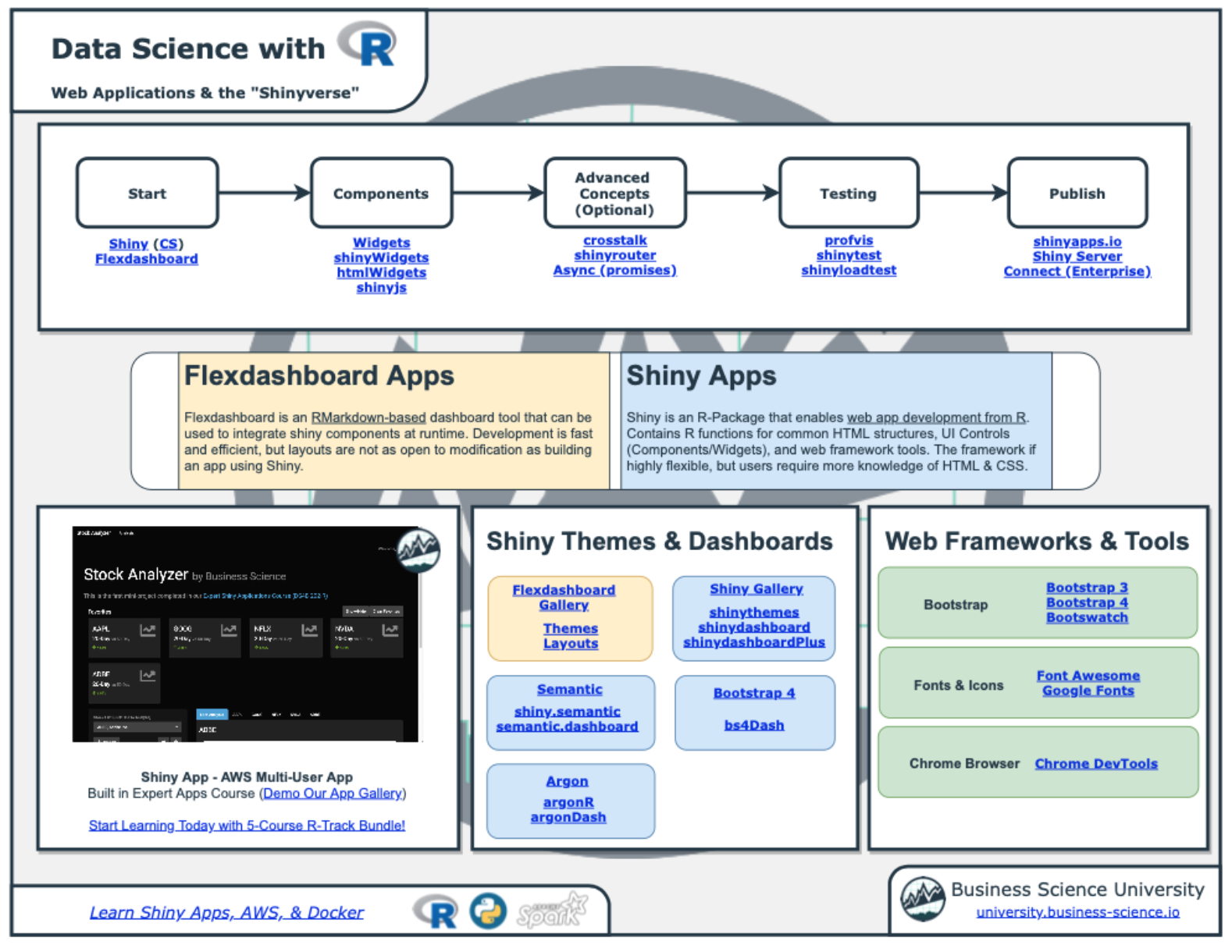5 Reasons You Should Learn Shiny
Written by Matt Dancho and Jarrell Chalmers

Many data scientists struggle with distributing their work. However, you can make that a problem of the past thanks to Shiny. The Shiny app is gold for Data Scientists. Here are five reasons you should learn Shiny and why it is a game-changer for upskilling your career.
As a companion to this article, we have the Ultimate R Cheatsheet. The “Shinyverse” is covered on Page 2, which is the ecosystem of packages that help you make superior shiny apps (See point 4. Shiny is an Ecosystem).
1. Shiny packages your analysis

Shiny is a powerful tool for building applications that package your analyses in a format that users can easily ingest. It’s designed to make it easy to distribute data science within an organization. Shiny enables people to make data-driven conclusions from your data science. This Stock Analyzer shiny app is built in our Shiny Developer with AWS Course. It helps in competitor stock analysis and financial analytics. This particular app is set up on AWS for multiple users (using a backend user-database) with authentication (so only the right people get access).
2. Shiny is 100X more scalable than business reports
Ever feel like people aren’t reading your reports? When you write a report and send out in an email via PDF attachment, only one user gets this. And it takes work for your users (business-people) to open up the report, interpret your results, and extract actionable information.

A better solution is to build a shiny app. Here’s an example of one of the Product Price Prediction Shiny app (one of 2 apps) that are built in our Shiny Predictive Dashboards Course. This app packages up the Product Pricing Algorithm shown in the previous report. Users can select new product attributes and the prices are estimated using it’s algorithm. Pretty handy for Sale & Marketing departments that need to determine pricing new variants of products every year.

3. Shiny automates analytics
Here’s a cool app - Shiny Zillow Price Explanations built in Learning Lab 28. When shiny fires up, you get new data and it automatically runs Machine Learning algorithms. Just search in the text box, and the app pulls in data for the home or property and it’s 10-closest comps (similar properties).

The shiny app then shows you which features are most important to the price. The waterfall chart shows that the property’s price is getting dinged because it was last sold for $131,000 and it’s finished square footage is only 1298 sq-ft (small). This is really useful for home buyers and sellers to know why their prospective property is priced the way it’s priced. All thanks to Shiny!

4. Shiny is an Ecosystem
Shiny has grown up from its days of being a bare-bones web framework. It now has a full ecosystem of packages that support it. As you can see from the Ultimate R Cheatsheet, there are several useful packages:
- Starting Frameworks:
shiny and flexdashboard
- Components and Themes:
shinyWidgets, shinyjs, bslib.
- Testing:
profvis and shinytest
- Publishing: Shiny Server, RStudio Connect

5. Shiny can save customers
Here’s a Brand Social Media Analyzer App that was built using a Twitter Sentiment Analysis in Learning Lab 32. Having access to important information about your business in an app helps you effectively market yourself to customers. This Shiny Twitter Sentiment Analyzer helps companies analyze their Brand Image.
Here we take a peek at Google’s twitter image. We can see that while sentiment ranges slightly positive, there are several issues. This is important information for their marketing, HR, branding teams to investigate.

How to Learn Shiny
Want to learn how to build shiny applications? You can become an expert Shiny Developer with our Shiny Developer w/ AWS Course.
Discover What’s Inside the Expert Shiny Developer with AWS Course

Shiny Developer with AWS Course is an amazing course designed to teach Data Scientists and Programmers how to develop applications and deploy into production!

You’ll learn how to build applications that connect to APIs, can manage multiple users, and are served on AWS with the use of Docker, Git, and NGINX. Here’s the application that you build.
